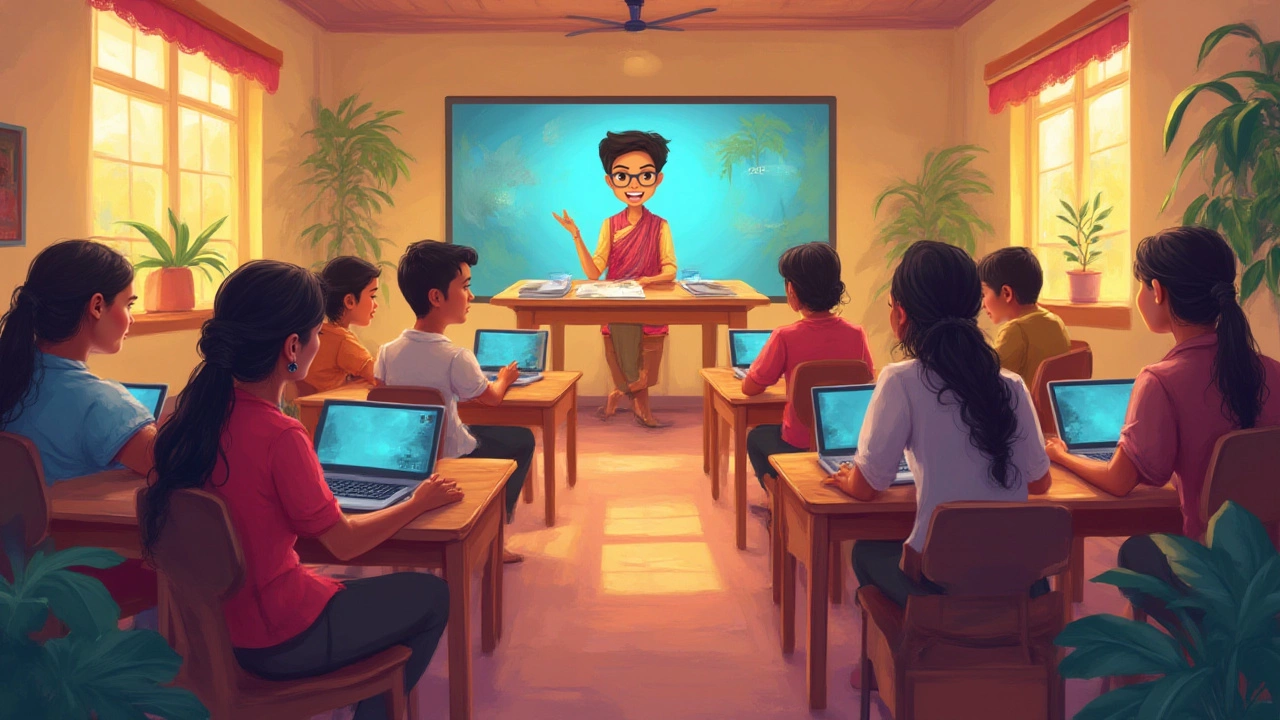Ever noticed how much learning has moved from blackboards and lecture halls to the glow of device screens? The world of eLearning isn’t just about clicking through endless slides or blurry video lectures. It’s dynamic, packed with choices, and can be custom-fit to just about anyone’s life. Not all eLearning is built the same, though—there are three main types, each with its own rules, rhythms, and advantages. Miss this, and you’ll risk ending up stuck with the wrong one.
Synchronous eLearning: Real-Time Connections
Picture a class where you’re meeting classmates and your instructor live—even if you’re both in your pajamas, sipping coffee 2,000 kilometers apart. That’s synchronous eLearning. It connects people in real time through webinars, virtual classrooms, or live chats. Imagine being in Mumbai, collaborating on a science project with someone in Toronto while your teacher moderates and answers questions instantly.
One huge draw is the immediate feedback. Stuck on a concept? Ask, and you get help within seconds. This is perfect if you love discussions, group work, or feel motivated when there’s structure and a calendar packed with deadlines. Teachers can spot confusion as it happens and adjust, making the experience feel a lot closer to traditional classrooms but with the perks of your home environment. Engagement gets a big boost, too—some universities report up to 40% higher participation in virtual live sessions compared to face-to-face ones.
But it comes with a catch—the schedule. You’ve got to show up on time, which can get tricky if your classmates live in different time zones. It also means less flexibility if your life is unpredictable. This suits people who crave routine or need that push of an external schedule, but not so much for night owls or those juggling work and family. Harvard Business Review recently pointed out that more than half of working adults who tried synchronous online courses said the rigid timing was their biggest challenge.
If you’re choosing a synchronous format, make sure you have reliable internet—a laggy connection can turn lively debates into a series of "Can you hear me now?" moments. Here’s a tip: always log in early for a tech check, and keep one device as a backup. Keeping your camera on, taking notes, and preparing questions ahead also ramps up your engagement, making the whole session a lot less passive.
Asynchronous eLearning: Learn Anytime, Anywhere
If waking up at 6 a.m. for a class makes you groan, asynchronous eLearning might be your hero. Here, lessons, quizzes, and resources are packaged so you can access them whenever it fits your schedule—midnight, your lunch break, or a lazy Saturday afternoon. There’s no live lecturer waiting; the content’s waiting for you, like a fridge stocked with meals you can enjoy whenever hunger strikes.
This format is a godsend for working professionals, parents, or anyone hustling several commitments at once. A 2023 report from Coursera revealed that over 70% of its learners choose courses primarily for the freedom to learn at their own pace. Even the most prestigious universities now blend asynchronous options into their curriculum, seeing how it lets people fit education around busy lives.
The big win with asynchronous eLearning is flexibility. Pause or rewind tough lessons, review recorded lectures, or spend extra time on tricky topics. You’re in the driver’s seat, which can be powerful if you’re motivated, organized, and curious. Discussion forums or message boards replace live debates, so you can still ask questions or share opinions—just not instantly. That does mean if you’re stuck, you might not get help right away. Some students mention “feeling on their own,” especially if instructors aren’t quick to reply.
One thing that helps? Keeping a weekly schedule. Treat those videos and readings like real appointments. Find a study buddy or join a group chat so you have people to bounce ideas off of. And don’t let assignments pile up—self-motivation is everything here. There’s a sweet spot: the flexibility means you can achieve more, but without structure, people sometimes end up doing less.
| Learning Type | Typical Use Case | Main Benefit | Biggest Challenge |
|---|---|---|---|
| Synchronous | Corporate training, live university lectures | Instant feedback | Scheduling conflicts |
| Asynchronous | Self-paced university courses, MOOC platforms | Maximum flexibility | Low engagement risk |
| Blended | K-12 education, professional development | Best of both worlds | Design complexity |

Blended Learning: The Hybrid Edge
Now, what if you want flexibility but still crave the energy of a live group? Blended learning brings it all together—it’s the smoothie of the education world, mixing in-person or live virtual classes with on-demand lessons and assignments. For instance, you might have a weekly Zoom discussion paired with self-paced readings and projects. This is the format many schools and businesses have landed on post-pandemic, seeing it fuels both engagement and freedom.
The stats back it up. A study by the U.S. Department of Education found that students in blended programs outperformed those in purely traditional or online classes. The main reason? The combo approach tackles different learning styles: live sessions for those who love to talk or debate, recorded materials for visual and independent learners. With blended learning, it’s way easier to keep up with deadlines and avoid that “where do I even start?” feeling.
But don’t expect perfect harmony every time. Blended learning can be tough to design well. If the transitions between live and self-paced parts aren’t clear, students might get confused. Instructors need to be as comfortable moderating a forum as they are leading a class. And if scheduling isn’t tight, you can end up with gaps—people losing touch between live sessions and not finishing the self-paced work. But when it’s done right, the blend is powerful. Schools like MIT and Stanford now roll out blended programs in hundreds of courses, reporting record levels of student satisfaction and graduation rates.
Here’s how to thrive in a blended environment: set reminders for both kinds of tasks. Prep your questions for live sessions by jotting them down while working through videos or readings. Use those in-person or real-time meetups to dive deep into what you found confusing. And don’t be shy about using support resources—FAQ pages, live help rooms, or peer groups—since missing out on any part can weaken the whole experience.
The Role of Technology and Platforms
You can’t talk about eLearning without digging into the tech that powers it. Platform choice can make or break the experience. Some, like Zoom, Microsoft Teams, and Google Meet, make synchronous learning possible with breakout rooms, polls, and instant screen-sharing. Asynchronous platforms—think Moodle, Coursera, or Udemy—let you binge content your way, with built-in quizzes, discussion boards, and sometimes even AI tutors to spot where you’re struggling.
What’s cool about today’s platforms is how they measure progress. Many give instant feedback on assignments, track time spent on tasks, and reward participation with badges or certificates. YouTube has become an accidental learning platform too, with tutorials and explainers covering everything from cooking to coding. The best platforms combine slick interfaces, mobile access, and easy communication tools. Accessibility features—like auto-captioning or adjustable playback speeds—help everyone, especially people with disabilities, get the most out of lessons.
Don’t just stick to the standard tools, though. Smart learners use apps like Notion, Quizlet, or Anki to organize notes and review key info on the go. Leveraging tools like shared Google Docs for group work or AI-based personal assistants can take your productivity to another level. Even simple tricks, like setting a browser shortcut to your course homepage, cut friction at the start of every session and help keep you on track.
As digital transformation shakes up workplaces worldwide, more than 90% of Fortune 500 companies now use custom eLearning platforms to train employees. That’s a big shift from just a decade ago when training meant conference rooms and binders. Flexibility, speed, and cost savings (some reports estimate companies save 50–70% compared to instructor-led training) are fueling this surge. Still, experts remind us that tech is just the vehicle—you need good content and a clear learning plan to actually get anywhere.

Choosing What’s Right for You
Picking the right eLearning type is about matching your habits, goals, and the quirks of your daily schedule—not just going with what everyone else is doing. If you thrive in social, highly structured settings, synchronous options are gold. Looking for ultimate freedom? Asynchronous is your zone. Want accountability but don’t want to be chained to a calendar? Dive into a blended format. Remember, what works for your friend or colleague might be torture for you. There’s no one-size-fits-all.
Ask yourself some quick questions: Do you need face-to-face time to stay motivated? Is your life so busy you can only study in bursts? Are you the type who needs reminders, or can you set your own pace? List your priorities, check what your course or school offers, and try out free demos if possible.
Never choose based on hype alone. Sometimes, people get swept up in trends or choose courses just because the tech looks cool—only to drop out a few weeks later. According to a 2024 Inside Higher Ed survey, completion rates for online courses are 30% higher when students had hands-on help picking the right format. If you’re unsure, talk to a counselor or ask current learners about their experience.
If you need a bit of inspiration, check this out:
"The future of learning is about access, engagement, and finding the right fit—no matter where you start from." — Salman Khan, Founder of Khan Academy
Whether you go live, on-demand, or hybrid, eLearning is only growing, changing, getting smarter. The possibilities are endless—and now you know exactly how to tell your synchronous from your asynchronous from your blended. Next time you pick a course, you’ll be way ahead of the curve.

